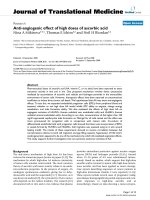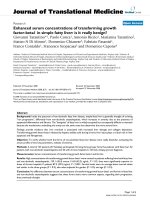Báo cáo hóa học: "Valence band offset of InN/BaTiO3 heterojunction measured by X-ray photoelectron spectroscopy" pot
Bạn đang xem bản rút gọn của tài liệu. Xem và tải ngay bản đầy đủ của tài liệu tại đây (288.61 KB, 5 trang )
NANO EXPRESS Open Access
Valence band offset of InN/BaTiO
3
heterojunction
measured by X-ray photoelectron spectroscopy
Caihong Jia
1,2
, Yonghai Chen
1*
, Yan Guo
1
, Xianglin Liu
1
, Shaoyan Yang
1
, Weifeng Zhang
2
and Zhanguo Wang
1
Abstract
X-ray photoelectron spectroscopy has been used to measure the valence band offset of the InN/BaTiO
3
heterojunction. It is found that a type-I band alignment forms at the interface. The valence band offset (VBO) and
conduction band offset (CBO ) are determined to be 2.25 ± 0.09 and 0.15 ± 0.09 eV, respectively. The experimental
VBO data is well consistent with the value that comes from transitivity rule. The accurate determination of VBO and
CBO is important for use of semiconductor/ferrroelectric heterojunction multifunctional devices.
Introduction
The semiconductor-ferroelectric heterostructures have
attr acted much attention due to their large potential for
new multifunctional electronic and optoelectronic device
applications [1-5]. Hysteres is properties of the ferroelec-
tric polarization allo w for bistable interface polarization
configuration The polarization coupling between the
fixed permanent semiconductor dipole and the switch-
able ferroelectric dipole can be exploited to modify the
electronic and the optical properties of a semiconductor
heterostructure. Recently, GaN-based high electron
mobility transistor devices have been integrated on fe r-
roelectric LiNbO
3
, providing the compact optoelectro-
nic/electronic chips with increased cost savings and
added functionality [ 6]. The semiconductor-ZnO/ferro-
electric-BaTiO
3
(BTO) heterostructure metal-insulator-
semiconductor field-effect transistors have been demon-
strated, in which the polarization of the BTO can be
used to control the free carrier concentration in the
ZnO channel [7]. In order to fully exploit the advantages
of semiconductor-ferroelectric heterostructures, other
combinations such as InN/BTO should be explored. As
a remarkable ferroelectric material with a high relative
permittivity, BTO can be used as a gate dielectric for
InN-based field-effect transistor. More importantly,
InN/BTO heterojunction is promising for fabricating
optical and e lectrical devices since oxidation t reatment
is found to reduce the surface electron accumulation of
InN films [8].
For heterostructure device s, it is important to accu-
rately determine the valence and the conduction band
offsets, which dictate the degree of charge carrier
separation and localization. However, up to date, there
is lack of experiment data available on the interface
band alignment p arameters for InN/BTO heterojunc-
tion. In this letter, we determine the VBO as well as
conduction band offset (CBO) values of the InN/BTO
heterojunction using X-ray photoelectron spectroscopy
(XPS).
Experimental
Three samples (bulk BTO, thick InN/BTO, and thin
InN/BTO) were studied in t his work, namely, a bulk
commercial (001) BTO substrate, a thick 200-nm InN
layer and a thin 5-nm InN layer grown on the commer-
cial (001) BTO substrates, respectively. To get a clean
interface, the BTO substrate was cleaned with organic
solvents and rinsed with de-ionized water sequentially
before loading into the reactor. The thick and thin het-
erostructures of InN/BTO were deposited by metal-
organic c hemical vapor deposition (MOCVD) at 520°C.
More growth condition details of the InN layer can be
found in our previous report [9]. XPSs were performed
on a PHI Quantera SXM instrument with Al Ka (hν =
1486.6 eV) as the X-ray radiation source, which had
been carefully calibrated on work function and Fermi
energy level (E
F
). Because a large amount of electrons
are excited and emitted from the sample, the sample is
always positively charged and the electric field caused by
* Correspondence:
1
Key Laboratory of Semiconductor Material Science, Institute of
Semiconductors, Chinese Academy of Science, P.O. Box 912, Beijing 100083,
PR China
Full list of author information is available at the end of the article
Jia et al. Nanoscale Research Letters 2011, 6:316
/>© 2011 Jia et al; licensee Springer. This is an Open Access article distributed under the terms of the Creative Commons Attribution
License ( which permits unrestricted use, distribution, and reproduction in any medium,
provided the original work is properly cited.
the charge can affect the m easured kinetic energy of
photoelectron. Charge neutralization was performed
with an electron flood gun and all XPS spectra were
calibrated by the C1s peak at 284.8 eV from contamina-
tion to compensate the charge effect. Since only the
relative energy position in each sample is needed to
determinetheVBO,theabsoluteenergycalibrationfor
a sample has no effect on the ultimate result. The sur-
faces of samples were examined initially by low-resolu-
tion survey scans to determine which elements were
present. Very high-resolution spectra were acquir ed to
determine the binding energy of core level and the
valence band maximum energy in the survey spectra.
Results and discussion
In X-ray θ-2θ diffraction measurements, as shown in
Figure 1, the thick InN/BTO sample presented the only
peak of InN (0002) reflection and no other InN-related
peaks were observed, implying a complete c-axis-
oriented growth of the InN layer. The VBO (ΔE
V
)can
be calculated from the formula
E
V
= E
CL
+(E
InN
In3d
− E
InN
VBM
) − (E
BTO
Ti2
p
− E
BTO
VBM
)
,
(1)
where
E
CL
=(E
InN/BTO
Ti2
p
− E
InN/BTO
In3d
)
istheenergydif-
ference between In3d and Ti2p core levels (CLs) mea-
sured in the thin heterojunction InN/BTO, while
(E
BTO
Ti2
p
− E
BTO
VBM
)
and
(E
InN
In3d
− E
InN
VBM
)
arethevalenceband
maximum (VBM) energies with reference to the CL
positions of bulk BTO and thick In N film, respectively.
Because all the sam ples were exposed to air, there must
be some impurities (e.g., oxygen and carbon) existi ng in
thesamplesurface,whichmaypreventtheprecise
determination of the positions of the VBMs. To reduce
the undesirable effects of surface contamination, all the
samples were cleaned by Ar
+
bombardment at a low
sputtering rate t o avoid damage to the samples. After
the bombardment, peaks related to impurities were
greatly reduced, and no new peaks appeared.
Figure 2 shows the XPS Ti2p and In3d CL narrow
scans and the valence band spectra from the bulk BTO,
thick InN, and thin InN/BTO samples, respectively. All
the CL spectra were fitted to Voigt (mixed Lorentz-
Gaussian) line shape with a Shirley background. The
uncertainty of the CL position is less than 0.03 eV, eval-
uated by n umerous fittings with different parameters.
The VBM positions were determined by linear extrapo-
lation of the leadin g edge of the VB spectra recorded on
the bulk BTO and thick InN film to the base lines to
account for the instrument resolution-induced tail [10].
Evidently, the VBM value is sensitive to the choice of
points on the leading edge used to obtain the regression
line [11]. Several different sets of points were selected
over the linear region of the leading edge to perform
regressions, and the uncertainty of VBO is found to be
less than 0.06 eV in the present work.
For the In3d spectra of both the InN and the thin
InN/BTO samples, additional low intensity higher-
binding-energy components were required. These extra
components are attributed to In-O bonding due to
oxide contamination when InN i s present at the sur-
face [12], as shown in Figure 2a. In the thin InN/BTO
sample shown in Figure 2c, they are attributed to In-O
bonding at the InN/BTO interfaces, and/or inelastic
losses to free carriers in the InN layer [13]. The CL
peak attributed to In-N bonding locates at 443.6 7 ±
0.03 and 443.98 ± 0.03 eV for thick InN and thin InN/
BTO, respectively, as shown in Figure 2a, c. From Fig-
ure 2b, it can be clearly seen that the Ti2p peak in the
bulk BTO is not symmetric and consists of two com-
ponents by careful Voigt fitting. The prominent one
located at 457.12 ± 0.03 eV is attributed to the Ti
emitters within the BTO substrate, which have six
bonds to oxygen atoms. The other one shifting by ~2
eV to a lower binding energy is attributed to TiO
x
suboxides on account of the TiO-terminated BTO
initial surface [14]. However, the Ti2p spectrum in the
thin InN/BTO hetero junction is quite symmetric, indi-
cating a uniform bonding state and the only peaks cor-
respondtoTi-Obonds.ItisinterestingthattheTi2p
peaks transform from asymmetry in bulk BTO to sym-
metry in the thin InN/BTO sample, as recently
observed in the thin ZnO/BTO heterostructure [15].
The VBM value of bulk BTO is determined to be 1.49
± 0.06 eV using the linear method. The Fermi energy
level of an insulator is expected to be located in the
middle of the forbidden energy gap, so the VBM will
be one-half of the band gap of insulators [16]. For
10 20 30 40 50 60 70 8
0
Intensity (arb. units.)
InN (002)
BTO (200)
BTO (002)
BTO (100)
BTO (001)
2T
(
de
g
.
)
Figure 1 X-ray θ-2θ diffraction pattern of the thick InN films on
BTO substrates.
Jia et al. Nanoscale Research Letters 2011, 6:316
/>Page 2 of 5
BTO, the VBM should be 1.55 eV calculated from the
band gap of 3.1 eV [17], which is in good agreement
with the measured value (1.49 ± 0.06 eV) in the pre-
sent work. Using th e same fitting met hods mentioned
above, the VBM value for the thick InN lms can be
determined to be 0.24 eV, as shown in Figure 1e. Sub-
stituting the above values in Equation 1, the resulting
VBO value is calculated to be 2.25 ± 0.09 eV.
The reliability of the measured result is analyzed by
considering several possible factors that could impact
the experiment results. The energy band bends down-
ward at the surface of InN film and there is an electron
accumulation layer [18], so the energy separation
between VBM and Fermi level can be changed at the
InN surface, which could impact the measured VBO
values of the heterojunctions. However, both the CL
emissions of In3d and Ti2p at the InN/BTO heterojunc-
tion are collected from the same surface (InN surface),
thus, the surface band bending effects can be canceled
out for the measurement of ΔE
CL
,aswasthemeasure-
ment of the band offset of the InN/AlN heterojunction
by others [19,20].
Another factor which may affect the precision of the
VBO value is the strain-induced piezoelectric field in
the overlayer of the heterojunction [21]. There is a large
lattice mismatch of about 7.1%
(
√
3a
InN
−
√
2a
BTO
√
2a
BT
O
× 100%
)
between the hexagonal apothem of InN and the
BTO
[
0
¯
11
]
direction. It is comparable with that of the
InN/ZnO heterojunction (7.7%), and the InN thin film
of 5 nm is approximately treated as completely relaxed
[10]. So the strain-induced piezoelectric field effect can
be neglected in our experiment. Since the factors that
can a ffect the ultimate result can be excluded from the
measured result, the experimental obtained VBO value
is somewhat reliable.
-20246
8
1.49 eV
(f) BTO: VBM
455 460 465
457.12 eV
(b) BTO: Ti 2p
Bindin
g
ener
gy
(
eV
)
Intens
i
ty
(
ar
b
. un
i
ts
)
455 460 465
458.43 eV
(d) InN/BTO: Ti 2p
-4-202468
0.24 eV
(e) InN: VBM
440 445 450 455
443.98 eV
(c) InN/BTO: In 3d
440 445 450 455
443.67 eV
(a) InN: In 3d
Figure 2 In3d spectra recorded on InN (a) and InN/BTO (e), Ti2p spectra on BTO (c) and InN/BTO (f), and VB spectra for InN (b) and
BTO (d). All peaks have been fitted to Voigt line shapes using Shirley background, and the VBM values are determined by linear extrapolation of
the leading edge to the base line. The errors in the peak positions and VBM are ±0.03 and ±0.06 eV, respectively.
Jia et al. Nanoscale Research Letters 2011, 6:316
/>Page 3 of 5
To further confirm the reliability of the experimental
values, it would be useful to compare our VBO value
with other results deduced by transitive property. For
hete rojunctions formed between all pairs of three mate-
rials (A, B, and C), ΔE
V
(A-C) can be deduced from the
difference between ΔE
V
(A-B) and ΔE
V
(C-B) neglecting
the interface effects [22]. The reported VBO values for
ZnO/BTO and InN/ZnO heterojunctions are ΔE
V
(ZnO-
BTO) = 0.48 eV [15], and ΔE
V
(InN-ZnO) = 1.76 eV
[23], respectively. Then the ΔE
V
(InN-BTO) is deduced
to be 2. 24 eV, which is well consistent with our mea-
sured value 2.25 ± 0.09 eV. In addition, the resulting
ΔE
V
is a large value for device applications which
require strong carrier con nement, such as light emitters
or heterostructure field effect transistors.
Finally, the C BO (ΔE
C
) can be estimated by the for-
mula
E
C
= E
BTO
g
− E
InN
g
− E
V
. By substituting the
band gap values at room temperature (
E
In
N
g
=0.7eV
[23] and
E
BT
O
g
= 3.1 eV [17]), ΔE
C
is calculated to be
0.15 ± 0.09 eV. Accordingly, a type-I band alignment
forms at the heterojunction interface, as shown in
Figure 3.
Conclusions
In summary, XPS was used to measure the VBO of the
InN/BTO heteroju nction. A type-I band alignment with
the VBO of 2.25 ± 0.09 eV and CBO of 0.15 ± 0.09 eV
is obtained. The acc urately determined result is impor-
tant for the design and application of InN/BTO hetero-
structure-based devices.
Abbreviations
CBO: conduction band offset; CLs: core levels; MOCVD: metal-organic
chemical vapor deposition; VBM: valence band maximum; VBO: valence
band offset; XPS: X-ray photoelectron spectroscopy.
Acknowledgements
This work was supported by the 973 program (2006CB604908,
2006CB921607), and the National Natural Science Foundation of China
(60625402, 60990313).
Author details
1
Key Laboratory of Semiconductor Material Science, Institute of
Semiconductors, Chinese Academy of Science, P.O. Box 912, Beijing 100083,
PR China
2
Key Laboratory of Photovoltaic Materials of Henan Province and
School of Physics Electronics, Henan University, Kaifeng 475004, PR China
Authors’ contributions
CJ carried out the experimental analysis and drafted the manuscript. YC
carried out the experimental design. YG participated in the experimental
analysis. XL carried out the growth and optimization of indium nitride films.
SY participated in the experimental measurement. WZ participated in its
design and coordination. ZW participated in the experimental design. All
authors read and approved the final manuscript.
Competing interests
The authors declare that they have no competing interests.
Received: 10 January 2011 Accepted: 8 April 2011
Published: 8 April 2011
References
1. Voora VM, Hofmann T, Schubert M, Brandt M, Lorenz M, Grundmann M,
Ashkenov N, Schubert M: Resistive hysteresis and interface charge
coupling in BaTiO
3
-ZnO heterostructures. Appl Phys Lett 2009, 94: 142904.
2. Voora VM, Hofmann T, Brandt M, Lorenz M, Grundmann M, Ashkenov N,
Schmidt H, Ianno N, Schbert M: Interface polarization coupling in
piezoelectric-semiconductor ferroelectric heterostructures. Phys Rev B
2010, 81: 195307.
3. Mbenkum BN, Ashkenov N, Schubert M, Lorentz M, Hochmuth H, Michel D,
Grundmann M, Wagner G: Temperature-dependent dielectric and electro-
optic properties of a ZnO-BaTiO
3
-ZnO heterostructure grown by pulsed-
laser deposition. Appl Phys Lett 2005, 86: 091904.
4. Losego MD, Kourkoutis LF, Mita S, Craft HS, Muller DA, Collazo R, Sitar Z,
Maria JP: Epitaxial Ba
0.5
Sr
0.5
TiO
3
-GaN heterostructures with abrupt
interfaces. J Cryst Growth 2009, 311: 1106.
5. Lorentz M, Bran di M, Schubert J, Hochmuth H, v Wenckstern H,
Schubert M, Grundmann M: Polarization coupling in epitaxial ZnO/
BaTiO
3
thin film heterostructures on SrTiO
3
(100) substrates. Proc SPIE
2007, 6474: 64741S.
6. Namkoong G, Lee KK, Madison SM, Henderson W, Doolittle WA, Ralph SE:
III-nitride integration on ferroelectric materials of lithium niobate by
molecular beam epitaxy. Appl Phys Lett 2005, 87: 171107.
7. Brandt M, Frenzel H, Hochmuth H, Lorentz M, Grundmann M, Schubert J:
Ferroelectric thin film field-effect transistors based on ZnO/BaTiO
3
heterostructures. J Vac Sci Technol B 2009, 27: 1789.
8. Cimalla V, Lebedev V, Wang CY, Ali M, Cke GE, Polyakov VM, Schwierz F,
Ambacher O, Lu H, Scha WJ: Reduced surface electron accumulation at
InN films by ozone induced oxidation. Appl Phys Lett 2007, 90: 152106.
9. Jia CH, Chen YH, Zhou XL, Liu GH, Guo Y, Liu XL, Yang SY, Wang ZG: InN
layers grown by MOCVD on SrTiO
3
substrates. J Cryst Growth 2010, 312:
373.
10. Zhang RQ, Zhang PF, Kang TT, Fan HB, Liu XL, Yang SY, Wei HY, Zhu QS,
Wang ZG: Determination of the valence band offset of wurtzite InN/ZnO
heterojunction by x-ray photoelectron spectroscopy. Appl Phys Lett 2007,
91: 162104.
11. Chambers SA, Droubay T, Kaspar TC, Gutowski M: Experimental
determination of valence band maxima for SrTiO
3
, TiO
2
, and SrO and
the associated valence band offsets with Si(001). J Vac Sci Technol B 2004,
22: 2205.
12. Piper LFJ, Veal TD, Walker M, Mahboob I, Mcconville CF, Lu H, Scha WJ:
Clean wurtzite InN surfaces prepared with atomic hydrogen. J Vac Sci
Technol A 2005, 23: 617.
13. King PDC, Veal TD, Lu H, Hatfield SA, Schaff WJ, Mcconville CF: The
influence of conduction band plasmons on core-level photoemission
spectra of InN. Surf Sci 2008, 602: 871.
BTO InN
E
Ti2
p
BTO
E
c
InN
E
v
InN
E
In3d
InN
E
c
BTO
E
v
BTO
E
g
BTO
=3.1 e
V
E
g
InN
=0.7 eV
(E
In3d
-E
v
)
InN
=443.43 eV
(E
Ti2p
-E
v
)
BTO
=455.63 eV
ǻE
c
=0.15 eV
ǻE
v
=2.25 eV
ǻE
CL
=14.45 eV
Figure 3 Energy band diagram of InN/BTO heterojunction.
Jia et al. Nanoscale Research Letters 2011, 6:316
/>Page 4 of 5
14. Kazzi ME, Merckling C, Delhaye G, Arzel L, Grenet G, Bergignat E,
Hollinger G: Photoemission (XPS and XPD) study of epitaxial LaAlO
3
film
grown on SrTiO
3
(0 0 1). Mater Sci Semicond Process 2006, 9: 954.
15. Jia CH, Chen YH, Zhou XL, Yang AL, Zheng GL, Liu XL, Yang SY, Wang ZG:
Valence band offset of ZnO/BaTiO
3
heterojunction measured by X-ray
photoelectron spectroscopy. Appl Phys A 2010, 99: 511.
16. You JB, Zhang XW, Song HP, Ying J, Guo Y, Yang AL, Yin ZG, Chen NF,
Zhu QS: Energy band alignment of SiO
2
/ZnO interface determined by x-
ray photoelectron spectroscopy. J Appl Phys 2009, 106: 043709.
17. Boggess TF, White JO, Valley GC: Two-photon absorption and anisotropic
transient energy transfer in BaTiO
3
with 1-psec excitation. J Opt Soc Am
B 1990, 7: 2255.
18. Mahboob I, Veal TD, Mcconville CF, Lu H, Scha WJ: Intrinsic Electron
Accumulation at Clean InN Surfaces. Phys Rev Lett 2004, 92: 036804.
19. Wu CL, Shen CH, Gwo S: Valence band offset of wurtzite InN/AlN
heterojunction determined by photoelectron spectroscopy. Appl Phys Lett
2006, 88: 032105.
20. King PDC, Veal TD, Jefferson PH, Mcconville CF, Wang T, Parbrook PJ, Lu H,
Scha WJ: Valence band offset of InN/AlN heterojunctions measured by x-
ray photoelectron spectroscopy. Appl Phys Lett 2007, 90: 132105.
21. Martin G, Botchkarev A, Rockett A, Morkoc H: Valence-band discontinuities
of wurtzite GaN, AlN, and InN heterojunctions measured by x-ray
photoemission spectroscopy. Appl Phys Lett 1996, 68: 2541.
22. Foulon Y, Priester C: Band-offset transitivity in strained (001)
heterointerfaces. Phys Rev B 1992, 45: 6259.
23. Yang AL, Song HP, Wei HY, Liu XL, Wang J, Lv XQ, Jin P, Yang SY, Zhu QS,
Wang ZG: Measurement of polar C-plane and nonpolar A-plane InN/ZnO
heterojunctions band offsets by x-ray photoelectron spectroscopy. Appl
Phys Lett 2009, 94: 163301.
doi:10.1186/1556-276X-6-316
Cite this article as: Jia et al.: Valence band offset of InN/BaTiO
3
heterojunction measured by X-ray photoelectron spectroscopy.
Nanoscale Research Letters 2011 6:316.
Submit your manuscript to a
journal and benefi t from:
7 Convenient online submission
7 Rigorous peer review
7 Immediate publication on acceptance
7 Open access: articles freely available online
7 High visibility within the fi eld
7 Retaining the copyright to your article
Submit your next manuscript at 7 springeropen.com
Jia et al. Nanoscale Research Letters 2011, 6:316
/>Page 5 of 5









